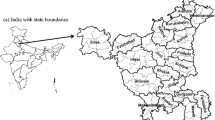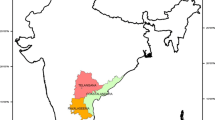Abstract
In this study, the spatial characteristics of agricultural drought vulnerability in China were investigated using a GIS-based agricultural drought vulnerability assessment model, which was constructed by selecting three agricultural drought vulnerability factors. Seasonal crop water deficiency, available soil water-holding capacity and irrigation were identified as the main indicators of agricultural drought vulnerability in China. The study showed that the distribution of seasonal crop moisture deficiency showed significant differentiation in both north–south and east–west directions, and the agricultural drought vulnerability presented a similar trend. At a regional scale, southern and eastern China typically has a low- and moderate-vulnerability to drought, while high and very high vulnerability to agricultural drought is observed in northern and western China. In terms of China’s agricultural regions, the central part of the southwest region, the area between the southern Huang-Huai-Hai region and the northern part of the Middle and lower reaches of the Yangtze River region, and the northeast region are the areas of low agricultural drought vulnerability in China, while areas of high agricultural drought vulnerability are mainly located in the Inner Mongolia, Loess Plateau and Gan-Xin regions. Due to differences in the physical and social–economic conditions within the agricultural areas, vulnerability to agricultural drought exhibits substantial variability both between different agricultural regions and within the same region. The methodology of grid-cell-based agricultural drought vulnerability assessment, developed in this study, provides a foundation for better description of the differences in regional and even smaller scale.






Similar content being viewed by others
References
Allen RG, Pereira LS, Raes D et al (1998) Crop evapotranspiration: guidelines for computing crop water requirement. FAO Irrigation and Drainage, Rome, p 56
Bella S, Nemeth A, Szalai S (2005) Examination of drought vulnerability with GIS tools: Somogyi county case study. Gottinger Geographische Abhandlungen 113:209–217
Blaikie P, Cannon T, Davis I, Wisner B (1994) At risk: natural hazards, people vulnerability, and disasters. Routledge Publisher, London and New York
Chen Y (1995) Main crop water requirement and irrigation of China. Water Resources and Hydropower Press, Beijing
Downing TE, Bakker K (2000) Drought discourse and vulnerability. In: Wilhite DA (ed) Drought: a global assessment, natural hazards and disasters series. Routledge Publishers, UK
Fang X, He Y, Zhang W (1997) An EOF analysis on drought effect on agriculture in China during 1978–1994. J Nat Disasters 6(1):59–64
Fu B (1991) Analysis of the geographical distribution and disastrous condition of drought in China. J Arid Land Resour Environ 5(4):1–7
Gao Z (2006) Development and action of irrigation in China. J Econ Water Resour 24(1):36–39
Hagman G (1984) Prevention better than cure. Report on human and environmental disasters in the third world. Swedish Red Cross, Stockholm. http://soils.usda.gov
Hutchinson MF (1991) The application of thin-plate smoothing splines to continent-wide data assimilation. In: Jasper JD (ed) Data assimilation systems, BMRC Res. report no. 27. Bureau of Meteorology, Melbourne, pp 104–113
IPCC (2001) Climate change 2001: impacts, adaptation and vulnerability of climate change, working group II report. Cambridge University Press, London
Kates RW (1985) The interaction of climate and society. In: Kates RW, Ausubel JH, Berberian M (eds) Climate impact assessment: studies of the interaction of climate and society. Wiley, Chichester
Keenan SP, Krannich RS (1997) The social context of perceived drought vulnerability. Rural Sociol 62:69–88
Kern JS (1995) Geographic patterns of soil water-holding capacity in the contiguous United States. Soil Sci Soc Amer 59:1126–1133
Klocke NL, Hergert GW (1990) How soil holds water, new guide G90-964, INAR. University of Nebraska, Lincoln
Knutson C, Hayes M, Phillips T (1998) How to reduce drought risk, western drought coordination council preparedness and mitigation group
Lei Z, Luo Y, Yang S, Shi X et al (1999) Calculation of crop coefficient with meteorological data. Tran Chin Soc Agric Eng 15(3):119–122
Li K, Yin S, Sha W (1996) Characters of time-space of recent drought in China. Geogr Res 15(3):6–15
Liu H, Kang Y (2006) Calculation of crop coefficient of winter wheat at elongation-heading stages. Trans Chin J Agric Eng 22(10):52–56
Liu Y, Pereira LS (2000) Validation of FAO methods for estimating crop coefficients. Tran Chin Soc Agric Eng 16(5):26–30
Liu C, Zhang X, You M (1998) Determination of daily evaporation and evapotranspiration of winter wheat field by large scale weighing lysimeter and micro lysimeter. J Hydraulic Eng 10:36–39
Liu L, Liu S, Liu P et al (2002) Synthetic analysis and quantitative estimation of the agricultural vulnerability to drought disaster in Hunan Province. J Nat Disasters 11(4):78–83
Liu M, Tang X, Zhuang D (2003) A new technique on spatial-temporal data fusion and construction of grid data platform. Geo-Inf Sci 4:63–68
Liu LF, Guan X, Tang Y-S (2005) Vulnerability of agricultural drought and agricultural losses reduction during drought through implementation of ecological measures—A case study of Hengyang, Hu-nan Province. Bull Soil Water Conserv 25(2):69–73
Marshall TJ (1979) Soil physics. Cambridge University Press, Cambridge
NCAR (2005) Drought’s growing reach: NCAR study points to global warming as key factor. http://www.ucar.edu/news/releases/2005/drought_research.shtml
Pan Y, Gong D, Wang P (1996) A research on temporal-spatial characteristics of drought in China during 1949–1990. J Beijing Norm Univ 32(1):138–143
Peng S, Ding J, Mao Z (2007) Estimation and verification of crop coefficient for water saving irrigation of late rice using the FAO-56 method. Trans Chin Soc Agric Eng 23(7):30–34
Ribot JC, Najam A, Watson G (1996) Climate variation, vulnerability and sustainable development in the semi-arid tropics. In: Ribot JC, Magalhães AR, Panagides SS (eds) Climate variability, climate change and social vulnerability in the semi-arid tropics. Cambridge University Press, New York, pp 13–51
Scotter DR (1981) Field capacity of water and soil available water. Soil Sci Am 45(5):852–855
Shahid S, Behrawan H (2007) Drought risk assessment in the west part of Bangladesh. Nat Hazards 46:391–413
Shang Y (1999) Agricultural drought disaster vulnerability assessment and the establishment of the correlation. J Hebei Norm Univ 23(3):420–428
Shang Y (2000a) Causes analysis of the changes of agricultural drought disaster vulnerability in Hebei Province. J Nat Disasters 9(1):40–46
Shang Y (2000b) The analysis of drought, agricultural drought disaster and the farmhouses vulnerability: taking the typical farmhouses of Xingtai County as an example. J Nat Disasters 9(2):55–61
Shang Y, Shi P (1998) Discussion on the role of anthropogenic factors in the forming of agricultural drought disaster process. J Nat Disasters 7(4):35–43
Shang Y, Huang D, Yang J (2006) Diagnosis and assessment of agricultural drought system’s vulnerability in irrigated area—taking Xingtai County of Hebei Province as an example. Areal Res Dev 25(5):117–121
Smith RM (1986) Comparing traditional methods for selecting class intervals on choropleth maps. Prof Geogr 38(1):62–67
Su Y, Li L, Wu Z-Z et al (2005) Analysis of hazard-affected body s vulnerability in formative process of agricultural drought: a case study on Dingcheng district in Hunan. J Nat Disasters 14(6):83–87
Sun J, Liu Z, Zhang J et al (2002) Crop coefficients of spring wheat in Windy dust area. Trans Chin Soc Agric Eng 18(6):55–58
Wang Y (1981) Affect of altitude to the two factors (δ/((δ+γ) and γ/((δ+γ) in Penman formula. Acta Meteorol Sin 39(4):503–506 (in Chinese)
Wang L, Chen S, Hou G (1988) Revision of Penman formula by altitude to calculate potential evapotranspiration. Acta Meteorol Sini 46(3):381–383 (in Chinese)
Wang J, Sun H, Xu W (2002) Spatio temporal change of drought disaster in China in recent 50 years. J Nat Disasters 11(2):1–6
Wang J, Shang Y, Su Y et al (2005a) A vulnerability diagnosis of agricultural drought disasters and regional sustainable development in China. J Beijing Norm Univ 3:031–731 (Social Science Edition)
Wang X, Liang W, Wen D (2005b) Analysis of paddy field evapotranspiration in North China and calculation of crop coefficient. Chin J Appl Ecol 16(1):69–72
Wang J, Su Y, Shang Y (2006) Vulnerability identification and assessment of agriculture drought disaster in China. Adv Earth Sci 21(2):161–168
Wilhelmi OV, Wilhite DA (2002) Assessing vulnerability to agricultural drought: a Nebraska case study. Nat Hazards 25:37–58
Wilhite DA (1993) The enigma of drought, chapter 1. In: Wilhite DA (ed) Drought assessment, management, and planning: theory and case studies. Kluwer Academic Publishers, Boston, MA, pp 3–17
Wilhite DA (2000) Drought as a natural hazard: concepts and definitions, chapter 1. In: Wilhite DA (ed) Drought: a global assessment, natural hazards and disasters series. Routledge Publishers, UK
Wu S, Yin Y, Zheng D et al (2005) Aridity/humidity status of land surface in China during the last three decades. Sci China Ser D Earth Sci 48(9):1510–1518
Yang X, Bouman BAM, Zhang Q et al (2006) Crop coefficient of aerobic rice in North China. Trans Chin Soc Agric Eng 22(2):37–41
Yin Y, Wu S, Zheng D et al (2005) Regional difference of aridity/humidity conditions changeover China during the last thirty years. Chin Sci Bull 50(19):2226–2233
Zhang F, Wang D, Qiu B (1987) China’s agricultural phrenology Atlas. Science Press, Beijing
Zhang X, Chen S, Pei D et al (2002) Evapotranspiration, yield and crop coefficient of irrigated maize under straw mulch conditions. Prog Geogr 21(6):583–592
Zuo D, Yixian W, Jiansui C (1993) Spatial distribution characteristics of solar radiation in China, Zuo Dakang’s geographical research papers in Chinese. Science Press, Beijing, pp 168–185
Acknowledgments
Foundation: National Natural Science Foundation of China, No. NSFC40601091; National Science and Technology Support Program of China, No. 2006BAD20B02 and No. 2006BAC18B06.
Author information
Authors and Affiliations
Corresponding author
Rights and permissions
About this article
Cite this article
Wu, J., He, B., Lü, A. et al. Quantitative assessment and spatial characteristics analysis of agricultural drought vulnerability in China. Nat Hazards 56, 785–801 (2011). https://doi.org/10.1007/s11069-010-9591-9
Received:
Accepted:
Published:
Issue Date:
DOI: https://doi.org/10.1007/s11069-010-9591-9




